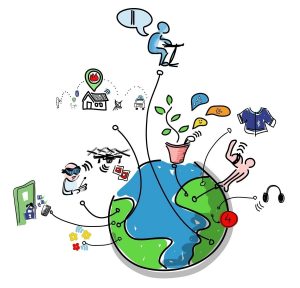 Wondering if this IoT business applies to you and your business? I’m sure you’re not alone, but this quick blog will hopefully start change your mind that it does. For more information, please click here to read “The Why, What and How of IoT – 50+ examples across 11 Industries.” The goal of this blog is to get you thinking about how your company can benefit and be disruptive in your industry. The guide mentioned above contains four areas:
Wondering if this IoT business applies to you and your business? I’m sure you’re not alone, but this quick blog will hopefully start change your mind that it does. For more information, please click here to read “The Why, What and How of IoT – 50+ examples across 11 Industries.” The goal of this blog is to get you thinking about how your company can benefit and be disruptive in your industry. The guide mentioned above contains four areas:
1. Current state of IoT
Have you considered how often you hear “smart” associated with something we talk about today; smart cars, smart buildings, smart manufacturing, smart healthcare, smart…? It’s all around and even our personal homes are becoming smarter. Most people have devices constantly with us which produce larges amounts of data and connect to so many things. There are senors that can detect when impact is sustained, if temperature changes, if someone is still looking at the screen and even simple notifications when the phone is picked up. These blend across personal use and industry. I’m adding more and more things to automate my house and make my families lives more comfortable; some may say lazy because we say “turn on light” instead of actually touching a switch. Analysts forecast that companies will invest $4.8 trillion in the IoT over the next five years! How much thought have you had to determine how this wave of technology can help you?
2. How the major industries are using IoT applications
In 2016, 43% of your peers have adopted IoT worldwide and the capabilities are still growing. Even the latest update in my home introduces more capabilities. Some make things easier, some add new functionality, or a new way of doing things. Sensors detect and react based on conditions are being widely used. Knowing that a piece of equipment is about to fail or have an issue is much better than finding out after it’s failed. I recall a time not so long ago, that the sensor actually missed that the packaging systems conveyor threw a package off it’s normal flow. This caused a back up and while we stood there dozens of packages fell to the floor. In no way am I saying all this technology is fool-proof, but it’s starting to help. Other sensors on the same line tested the product and reported the ingredients of the package. Yes, this is a food example and it tested to make sure the end product had the right amount of everything expected and sent alerts if sodium was too high, for example…
The PDF includes so many other industries and success stories, it’s very exciting to read! Companies like Delphi are helping improve driver safety. With the connected systems now available (many were before, just not enabled) more drivers are understanding the importance of being focused on the road and surroundings while driving. Many cars now have the indicators from mirrors and other areas of the vehicle that light up or even vibrate the seat to make the driver aware. I hope you’re using those mirrors and have them setup correctly when you’re driving. Don’t forget, if you pass a vehicle and still can’t see them in the rear view mirror, you might not have completely passed them (Ha, just recalled an old safety video memory from my John Deere days).
3. What’s a strategic process to implement IoT?
How do you get started? (there are way more details in the PDF – 26 pages actually)
ONE – Understand and define the critical path (what’s in it for your business, what do you hope to get out of it)
TWO – Determine what metrics you need to also define those critical moments (what do you do when you find something)
THREE – Create an IoT proof of concept (there are many sensors out there, test a few, they’re cheap and validate it gathers what you expect / need)
FOUR – Build a plan to capture, monitor and respond to your system (how does it all fit together and setup success criteria)
4. Five considerations for IoT
Ooh, they’re good ones and I’ll leave this one for the paper so you can download it (repeat, click here).
I only touched on a couple of the many industries within the paper, hope you’ll download and read the details. This isn’t just for Maximo clients, rather anyone in any industry. I challenge you to find a new way of doing things with some of these great technologies.